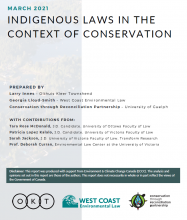
Indigenous Protected and Conserved Areas (IPCAs) are defined by the Indigenous Circle of Experts (ICE) as “lands and waters where Indigenous governments have the primary role in protecting and conserving ecosystems through Indigenous laws, governance and knowledge systems.”
The recent recognition of IPCAs as an effective form of conservation in Canada provides new opportunities. There is a growing consensus that Indigenous peoples’ millennia-long experiences of governing their lands and waters is more effective than that of the conservation-based practices established by Canadian government bodies.
This report examines two IPCAs – SGaan Kinghlas-Bowie Seamount Marine Protected Area in Haida Gwaii and Thaidene Nëné in Łutsël K’é Dene First Nation territory – looking at how Indigenous laws are being applied in each context. The report considers the opportunities and challenges of joint jurisdiction from both a theoretical and practical perspective, and provides recommendations on how recognition of Indigenous jurisdictions and authorities for the establishment and operation of IPCAs can advance effective conservation and provide a pathway for reconciliation.
Prepared by:
Larry Innes, Olthuis Kleer Townshend
Georgia Lloyd-Smith, West Coast Environmental Law
Conservation through Reconciliation Partnership, University of Guelph
With contributions from: Tara Rose McDonald, Patricia Lopez Kalalo, Sarah Jackson, and Prof. Deborah Curran
This report was produced with support from Environment & Climate Change Canada (ECCC).